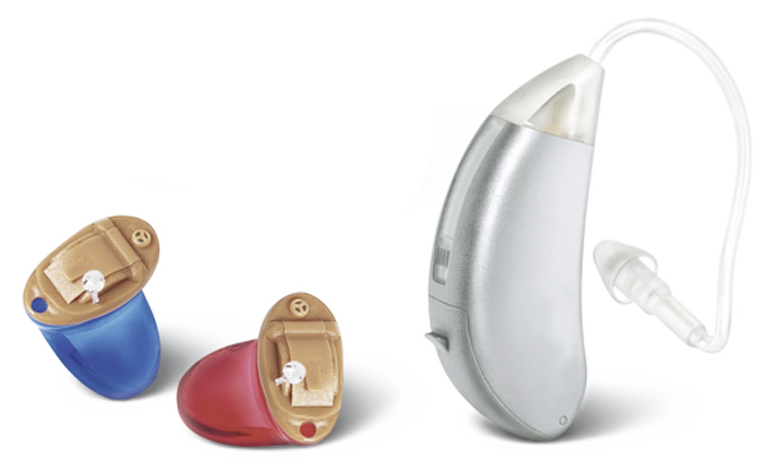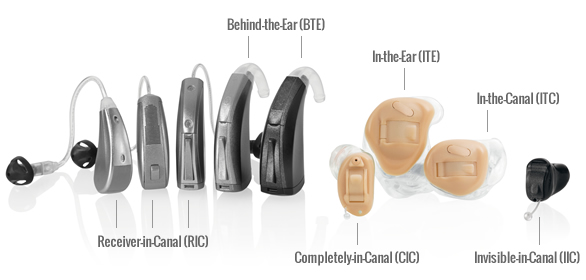Hearing Aid Styles
With new technology emerging it seems like hearing aids are changing all the time. With so many models on the market it can sometimes get confusing deciphering what type of hearing aid does what.
To help you shop hearing aids and features at home, we are pleased to offer you instant access the short information guides found below. Armed with core knowledge for comparing types of hearing aids, you can work with us at Parker Hearing Institute to pick the right hearing aid for you.
Please, keep in mind that most modern hearing aids offer wireless and Bluetooth options. The uses of these hearing aids can also be found below.


Receiver-in-Canal (RIC)
Receiver-in-Canal (RIC) models, also known as RITE (receiver-in-the-ear), are mini BTEs that have the receiver (speaker) of the instrument incorporated in the ear tip, instead of in the main body of the instrument. RIC instruments fit mild to severe hearing losses and looks similar to the OTE when worn on the ear.
Completely-in-Canal (CIC) & Invisible-in-Canal (IIC)
CIC and IIC models are also custom-made with your canal mold to fit deep in the ear canal, seeming to be “invisible”. While offering cosmetic advantages, these tiny devices have limitations, including shorter battery life, size restrictions due to ear anatomy, proneness to wax/moisture damage, and limited controls/functionality.
In-The-Ear (ITE) and In-The-Canal (ITC)
ITE and ITC models are custom-made and fit in the outer ear bowl. We make a mold of your ear canal and outer ear, which we send to the manufacturer. Their size allows for additional controls and features such as directional microphones, which require space on the outer portion of the instrument. Some can fit a larger receiver with enough power for even severe hearing losses. In cases of arthritis or poor dexterity, the ITE is usually easier for an individual to handle and control due to its’ larger size.
Behind-the-Ear (BTE)
Behind-the-Ear (BTE) models sit behind or on top of the outer ear, with tubing that routes sounds down into the ear, that is connected to an ear dome or earmold to secure them in the ear canal. Modern BTEs come in colors to blend with hair tones, chrome colors, leopard print and other designs to suit personal styles. Different BTE sizes allows users to choose features (circuits) important to them: more power, wireless/Bluetooth compatibility, discreetness, ease of handling, battery size and life.
BTEs with earmolds fit mild through profound hearing losses. They generally can house more features, controls, and power than custom models. This style can be very advantageous for someone with frequent drainage or heavy accumulation of wax in the ear, since all electronics are housed behind the ear.
Over-the-Ear (OTE)
OTEs are ‘mini-BTEs’ with ultra-thin tubing to discreetly route sound into the ear. The tubing connects to a soft tip that sits in the ear canal but doesn’t occlude it. These are popular for their comfort and more natural sound (the ear canal is not plugged). This is known as an ‘open fit hearing aid’ and is recommended for mild to moderate high frequency losses.
Wireless and Bluetooth
With wireless technology you can*:
- Automatically stream your television, radio, computer, or MP3 player directly to your hearing aids with comfort and clarity like never before.
- Experience a noticeable decrease in whistling and buzzing (feedback) when interacting with electronic devices.
- Enjoy a hands-free cell phone experience by connecting directly to your hearing aids via Bluetooth® Technology
- Transfer between devices without manually adjusting your hearing aids. When you turn off the television to enjoy the music in the your dining room, your wireless device knows.
*Not all styles include wireless technology.
Parker Hearing Institute – We’re Better Because WE Care!
Call today to schedule your appointment or learn more – (310)540-4327
With new technology emerging it seems like hearing aids are changing all the time. With so many models on the market it can sometimes get confusing deciphering what type of hearing aid does what.
To help you shop hearing aids and features at home, we are pleased to offer you instant access the short information guides found below. Armed with core knowledge for comparing types of hearing aids, you can work with us at Parker Hearing Institute to pick the right hearing aid for you.
Please, keep in mind that most modern hearing aids offer wireless and Bluetooth options. The uses of these hearing aids can also be found below.
Receiver-in-Canal (RIC)
Receiver-in-Canal (RIC) models, also known as RITE (receiver-in-the-ear), are mini BTEs that have the receiver (speaker) of the instrument incorporated in the ear tip, instead of in the main body of the instrument. RIC instruments fit mild to severe hearing losses and looks similar to the OTE when worn on the ear.
Completely-in-Canal (CIC) & Invisible-in-Canal (IIC)
CIC and IIC models are also custom-made with your canal mold to fit deep in the ear canal, seeming to be “invisible”. While offering cosmetic advantages, these tiny devices have limitations, including shorter battery life, size restrictions due to ear anatomy, proneness to wax/moisture damage, and limited controls/functionality.
In-The-Ear (ITE) and In-The-Canal (ITC)
ITE and ITC models are custom-made and fit in the outer ear bowl. We make a mold of your ear canal and outer ear, which we send to the manufacturer. Their size allows for additional controls and features such as directional microphones, which require space on the outer portion of the instrument. Some can fit a larger receiver with enough power for even severe hearing losses. In cases of arthritis or poor dexterity, the ITE is usually easier for an individual to handle and control due to its’ larger size.
Behind-the-Ear (BTE)
Behind-the-Ear (BTE) models sit behind or on top of the outer ear, with tubing that routes sounds down into the ear, that is connected to an ear dome or earmold to secure them in the ear canal. Modern BTEs come in colors to blend with hair tones, chrome colors, leopard print and other designs to suit personal styles. Different BTE sizes allows users to choose features (circuits) important to them: more power, wireless/Bluetooth compatibility, discreetness, ease of handling, battery size and life.
BTEs with earmolds fit mild through profound hearing losses. They generally can house more features, controls, and power than custom models. This style can be very advantageous for someone with frequent drainage or heavy accumulation of wax in the ear, since all electronics are housed behind the ear.
Over-the-Ear (OTE)
OTEs are ‘mini-BTEs’ with ultra-thin tubing to discreetly route sound into the ear. The tubing connects to a soft tip that sits in the ear canal but doesn’t occlude it. These are popular for their comfort and more natural sound (the ear canal is not plugged). This is known as an ‘open fit hearing aid’ and is recommended for mild to moderate high frequency losses.
Wireless and Bluetooth
With wireless technology you can*:
-
Automatically stream your television, radio, computer, or MP3 player directly to your hearing aids with comfort and clarity like never before.
-
Experience a noticeable decrease in whistling and buzzing (feedback) when interacting with electronic devices.
-
Enjoy a hands-free cell phone experience by connecting directly to your hearing aids via Bluetooth® Technology
-
Transfer between devices without manually adjusting your hearing aids. When you turn off the television to enjoy the music in the your dining room, your wireless device knows.
*Not all styles include wireless technology.


